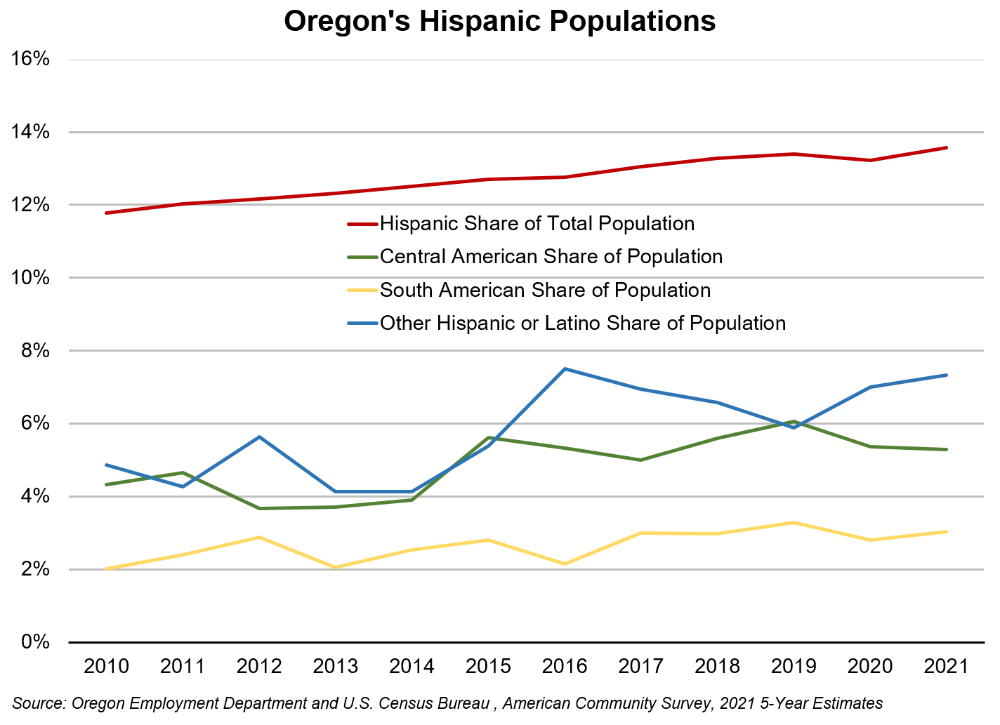Oregon’s Growing Hispanic Workforce
September 20, 2023Oregon’s Hispanic population continues to increase as does the number of Hispanics in Oregon’s labor force. The Hispanic population has a similar unemployment rate and a higher labor force participation rate than whites who are not Hispanic. Earnings and educational attainment are also increasing for Hispanics in Oregon.
Hispanics Are a Growing Part of Oregon’s Population and Workforce
From 2006 through 2010, Hispanics were an average of 8.9% of Oregon’s population ages 16 and over, according to the Census Bureau’s American Community Survey. Hispanics had a higher rate of labor force participation (73.5%) than non-Hispanic whites (63.4%), and they had a higher rate of employment (66.0%) than non-Hispanic whites (58.1%).
As the economy improved after the Great Recession in the years 2013 through 2017, labor force participation dipped slightly for both Hispanics and non-Hispanic whites. (The labor force includes both employed and unemployed people and can decline as the number of unemployed people declines.) The share of people who were employed diverged for the two groups, however. The average share of Hispanics who were employed increased slightly to 66.9% and the share of non-Hispanic whites who were employed decreased to 56.7%.
In recent years, the Hispanic population has grown to account for nearly 14% of the population in Oregon and continues to make up a significant and growing portion of our labor force. Between 2017 and 2021, Hispanics had the third-highest employment-to-population ratio (68.2%) of all major racial and ethnic groups published by the Census Bureau. The only groups with a higher employment ratio were “Some Other Race Alone” with 68.9% and “Native Hawaiian and Other Pacific Islander” with 68.4% of the population employed.
Hispanic workers are employed throughout Oregon’s economy. In 2021, the health care and social assistance industry was the greatest source of employment for Hispanic workers, employing about 13% of Oregon’s Hispanic workforce. Other major industries of employment were manufacturing (13% of Oregon’s Hispanic workforce), accommodation and food services (12%), and retail trade (11%).
Median Earnings, Educational Attainment on the Rise for Hispanics
Median earnings and educational attainment have increased for Hispanic Oregonians over the last decade, although they still trail behind non-Hispanic whites. The median earnings for Hispanics was $31,505 in 2021, up from $18,681 in 2011. This still fell below non-Hispanic whites, who had median earnings of $44,507 in 2021.
Educational attainment has also risen for Hispanics over the last decade. The percentage of Hispanic Oregonians 25 years and older with a bachelor’s degree or higher rose from 11% in 2011 to 18% in 2021. Despite improvements, educational attainment for Hispanics still fell below their non-Hispanic white counterparts, around 36% of whom had a bachelor’s degree or higher at an age of 25 or older.
Make-up of Oregon’s Hispanic Population Continues to Evolve
A small but increasing percentage of Hispanics state that their origin is from areas other than Mexico. The shares of Hispanics from South America, Central America, and other areas, such as Spain, have been generally increasing since at least 2010 and the share of Hispanics in the state who claim an origin from Mexico dropped from 85% in 2011 to 80% in 2021. After Mexico, the second largest share was Hispanics who claimed a Puerto Rican origin (2.7%), followed by a Guatemalan origin (2.1%), and a Spanish origin (2.0%).

One reason that an increasing share of Oregonians are Hispanics may be because they have had larger average family sizes than non-Hispanics, although this difference has been decreasing. In 2010, the average family size for Hispanic households in Oregon was 3.93 people, and for non-Hispanics it was 3.05 people. In 2019, the average size for Hispanic households dropped to 3.70 people, and for non-Hispanics it was 3.03 people.
The growth of the Hispanic population has attracted research into its national economic benefits. In their working paper The Economic Benefits of Latino Immigration, Gonzalo Huertas and Jacob Funk Kirkegaard of the Peterson Institute for International Economics estimate that, “The Hispanic demographic dividend will likely contribute 0.21 percentage point to the annual real GDP growth rate over the next 25 years.” UNIDOS U.S. estimates that 30% of the U.S. workforce will be Hispanic by 2050. And finally, Robert W. Fairlie and others at the Kauffman Foundation have shown that Hispanics have the highest rate of entrepreneurship (business startup) of any major racial and ethnic group.
Much of this outsized economic impact is due to the younger age structure of the Hispanic population in Oregon. The median age of Hispanics in Oregon was 27.6 in 2021, considerably younger than non-Hispanic whites (44.2) or Oregonians in general (40.1). The increasing share of Hispanics in Oregon bodes well for the state’s economic future.